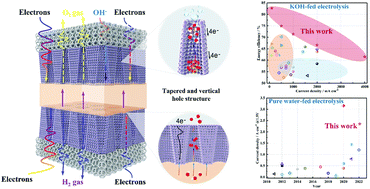Overall design of novel 3D-ordered MEA with drastically enhanced mass transport for alkaline electrolyzers†
Abstract
The generation of hydrogen via alkaline electrolyzers is a promising approach for addressing the severe energy crisis. However, alkaline electrolyzers with alkaline electrolytes or pure water suffer from poor performance compared to proton exchange membrane (PEM) electrolyzers. Here, in order to improve the energy conversion efficiency and durability, especially at high current density, a novel three-dimensionally (3D)-ordered membrane electrode assembly (MEA) based on highly porous catalyst layers (CLs) with unique vertical channels, an ultrathin membrane layer (ML) and 3D CL/ML interface structures was nanoengineered for alkaline electrolyzers. Benefiting from the mass-transfer highways constructed by the overall design of the 3D-ordered MEA, a high current density of 4200 mA cm−2 was achieved at 2.0 V in 1 M KOH, which is superior compared with the other best-performing alkaline electrolyzers. Moreover, alkaline electrolyzers fed with pure water achieved a performance of 3100 mA cm−2 at 2.0 V. Notably, the pure-water-fed alkaline electrolyzers can maintain over 600 h at a high current density of 1 A cm−2. By revealing the relationship between the MEA structure and mass transfer, our work opens a simple, cost-effective, and scalable route to prepare 3D-ordered MEAs for alkaline electrolyzers.



 Please wait while we load your content...
Please wait while we load your content...